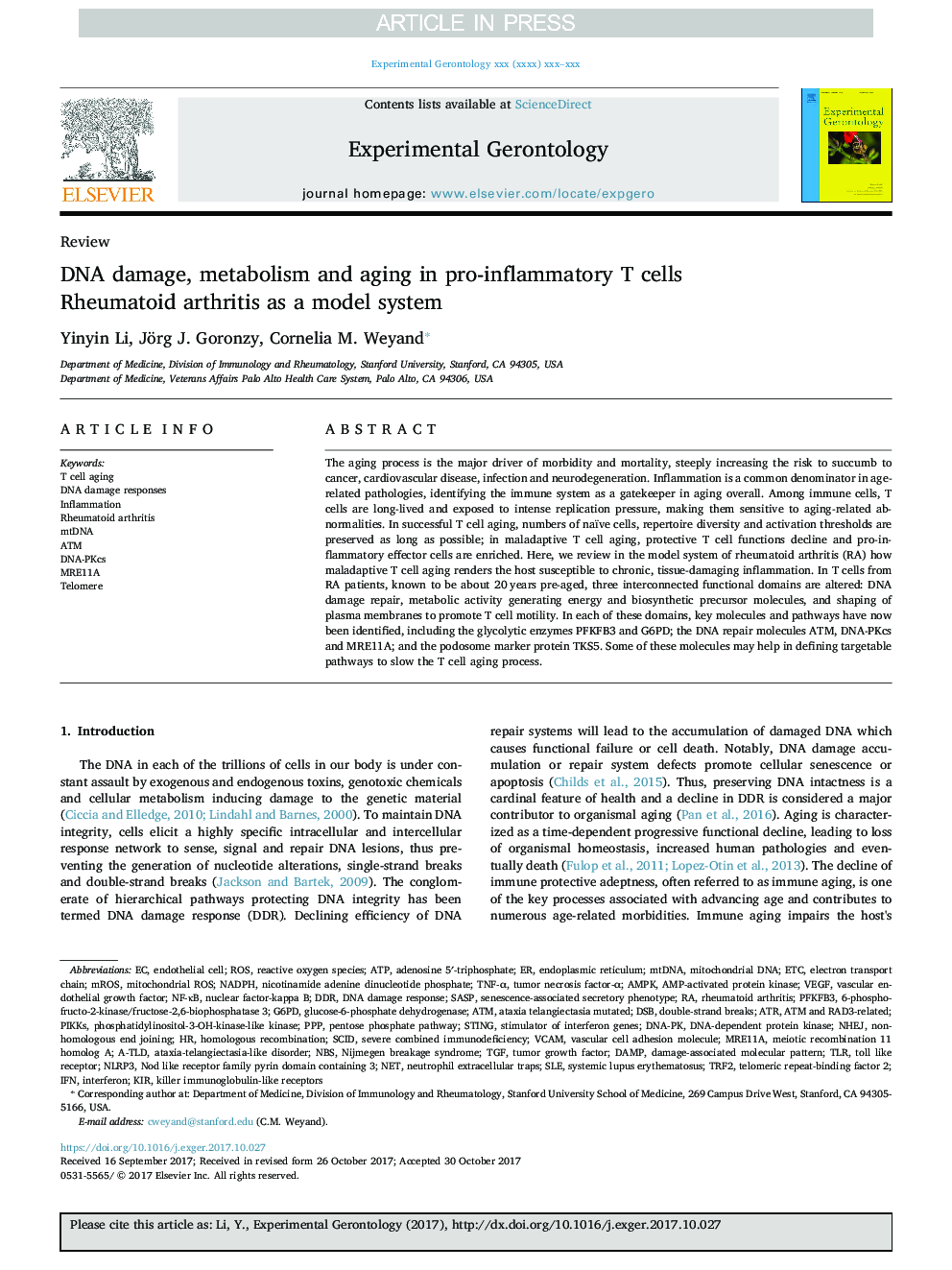| کد مقاله | کد نشریه | سال انتشار | مقاله انگلیسی | نسخه تمام متن |
|---|---|---|---|---|
| 8262437 | 1534837 | 2018 | 10 صفحه PDF | دانلود رایگان |
عنوان انگلیسی مقاله ISI
DNA damage, metabolism and aging in pro-inflammatory T cells
دانلود مقاله + سفارش ترجمه
دانلود مقاله ISI انگلیسی
رایگان برای ایرانیان
کلمات کلیدی
AMPKNHEJDAMPPPPNADPHNBSVCAMNLRP3G6PDTLRTGFDDRKirSASPDNA-PKATRMrOSSCIDATM and Rad3-relatedDNA-PKcsPFKFB3TRF2DSBDNA damage responsesNF-κBAMP-activated protein kinase - AMP-پروتئین کیناز فعال شده استataxia telangiectasia mutated - Ataxia telangiectasia جهش یافته استMitochondrial DNA - DNA میتوکندریاROS - ROSmitochondrial ROS - ROS میتوکندریadenosine 5′-triphosphate - آدنوزین 5'-تری فسفاتATP - آدنوزین تری فسفات یا ATPRheumatoid arthritis - آرتریتروماتوئیدinflammation - التهاب( توروم) damage-associated molecular pattern - الگوی مولکولی مرتبط با آسیبinterferon - اینترفرونIFN - اینترفرون هاtoll like receptor - تلفات مانند گیرندهneutrophil extracellular traps - تله های خارج سلولی نوتروفیلTelomere - تلومرtumor necrosis factor-α - تومور نکروز عامل αNET - خالصATM - خودپردازmtDNA - دیانای میتوکندریاییelectron transport chain - زنجیره انتقال الکترونEndothelial cell - سلول های اندوتلیالNijmegen breakage syndrome - سندرم شکستن نیهمگنendoplasmic reticulum - شبکه آندوپلاسمی double-strand breaks - شکست دو ردیفtumor growth factor - عامل رشد تومورnon-homologous end joining - عدم پیوستن انتهای غیر همولوگVascular endothelial growth factor - فاکتور رشد اندوتلیال عروقیVascular Endothelial Growth Factor (VEGF) - فاکتور رشد اندوتلیال عروقی (VEGF)TNF-α - فاکتور نکروز توموری آلفاNuclear factor-kappa B - فاکتور هسته ای-کاپا BSenescence-associated secretory phenotype - فنوتیپ ترشحی مرتبط با سن زاییSystemic lupus erythematosus - لوپوس اریتماتوی سیستمیکSLE - لوپوس منتشر یا لوپوس اریتماتوس سیستمیکstimulator of interferon genes - محرک ژن های اینترفرونpentose phosphate pathway - مسیر پنتوز فسفاتvascular cell adhesion molecule - مولکول چسبندگی سلولی عروقیHomologous recombination - نوترکیبی همولوگSTING - نیشnicotinamide adenine dinucleotide phosphate - نیکوتین آمید adenine dinucleotide phosphateETc - و غیرهDNA-dependent protein kinase - وابسته به پروتئین کیناز وابسته به DNADNA damage response - واکنش به آسیب DNA severe combined immunodeficiency - کمبود شدید مصدومglucose-6-phosphate dehydrogenase - گلوکز 6-فسفات دهیدروژنازReactive oxygen species - گونههای فعال اکسیژنkiller immunoglobulin-like receptors - گیرنده های ایمونوگلوبولین مشابه قاتل
موضوعات مرتبط
علوم زیستی و بیوفناوری
بیوشیمی، ژنتیک و زیست شناسی مولکولی
سالمندی
پیش نمایش صفحه اول مقاله

چکیده انگلیسی
The aging process is the major driver of morbidity and mortality, steeply increasing the risk to succumb to cancer, cardiovascular disease, infection and neurodegeneration. Inflammation is a common denominator in age-related pathologies, identifying the immune system as a gatekeeper in aging overall. Among immune cells, T cells are long-lived and exposed to intense replication pressure, making them sensitive to aging-related abnormalities. In successful T cell aging, numbers of naïve cells, repertoire diversity and activation thresholds are preserved as long as possible; in maladaptive T cell aging, protective T cell functions decline and pro-inflammatory effector cells are enriched. Here, we review in the model system of rheumatoid arthritis (RA) how maladaptive T cell aging renders the host susceptible to chronic, tissue-damaging inflammation. In T cells from RA patients, known to be about 20Â years pre-aged, three interconnected functional domains are altered: DNA damage repair, metabolic activity generating energy and biosynthetic precursor molecules, and shaping of plasma membranes to promote T cell motility. In each of these domains, key molecules and pathways have now been identified, including the glycolytic enzymes PFKFB3 and G6PD; the DNA repair molecules ATM, DNA-PKcs and MRE11A; and the podosome marker protein TKS5. Some of these molecules may help in defining targetable pathways to slow the T cell aging process.
ناشر
Database: Elsevier - ScienceDirect (ساینس دایرکت)
Journal: Experimental Gerontology - Volume 105, May 2018, Pages 118-127
Journal: Experimental Gerontology - Volume 105, May 2018, Pages 118-127
نویسندگان
Yinyin Li, Jörg J. Goronzy, Cornelia M. Weyand,